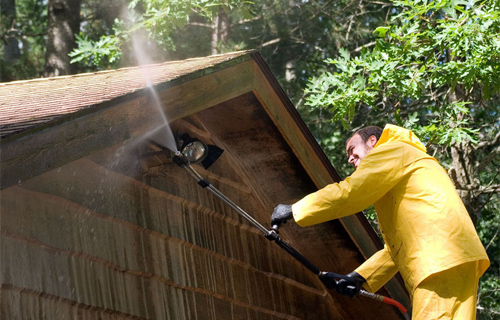Do You Risk Asbestos Exposure during Spring Cleaning?

It has become the habit of millions of Americans to do a deep spring cleaning for reasons varying from wanting to declutter their house by getting rid of all the junk that does not actually have any purpose anymore, to updating the decor and making it more appealing to their current tastes or performing renovation work in the areas in need of some adjustments.
The majority of the United States population, however, fails to consider that such an activity might end up threatening their well being by disturbing hazardous substances indoors or outdoors. In the cases of older homes, particularly those that have been constructed before the 1980s, the primary hazardous concern should be a mineral called asbestos, which was used widely in the first half of the 20th century in the construction field.
Asbestos demonstrated strength and durability, as well as a high resistance to fire which is why the fibers were poured into building supplies in order to increase their endurance. Among the most common uses of asbestos when it came to building a house were related to bricks, pipes, flooring and roofing.
Asbestos Use and the American Homeowner
Even at the present, asbestos usage is not entirely banned in the U.S. so there is a possibility that an asbestos item will find its way into your home, however, according to the current regulation, if the product contains less than 1% of the toxic mineral than it is not a reason for concern.
In fact, asbestos, in general, should not be feared unless it becomes airborne making it easier for it to be inhaled or ingested by those in the surrounding area. The mineral has been linked to some terrible diseases, most common of which are lung cancer, asbestosis and mesothelioma, which, as medical records have noted, have been diagnosed decades after the exposure occurred, this long latency period having deceived many into thinking that asbestos dust was not damaging their health in any way.
If you live in an older home and you're determined to go through with your spring cleaning plan, it would be best if you had your house inspected, both on the inside and on the outside, for asbestos before you begin dusting, scrubbing and drilling so that you may proceed without that nagging feeling that you're doing something risky.
Where Can Asbestos Be Found in the House?
There are a few areas in older buildings that have frequently tested positive for asbestos and you should consider a professional evaluation of these spaces so that you do not accidentally turn your home into a hazardous environment by repairing, renovating or by simply cleaning.
The intense use of asbestos in the first part of the last century made the mineral become interchangeable with insulation both in concept and in terminology. Therefore, if you know that your house was built at the time that asbestos was dominating the market, the first thing that you should check is the insulation, particularly in the case of boilers or attics.
If you notice a pebble-like material that is of the gray-brown or silver-gold color, that might be vermiculite which is highly likely to be contaminated with asbestos.
Electrical Panels
Electrical panels are also a good device to check because their role in distributing electricity, and implicitly in producing heat in the wiring, have made them the target of asbestos insulation, making use of the low conductivity of the mineral in an attempt to prevent the occurrence of flames.
Pipes
Similarly, the piping system in your house might be covered in asbestos since it worked in reducing heat loss, but it was also a countermeasure to keep the pipes from freezing and at the same time protected from the surfaces around them.
Vinyl Floor Tiles
The durability of asbestos also inspired manufacturers to add it to vinyl floor tiles as well as tile adhesives in order to make the materials much stronger and resistant to deterioration. If there are visible cracks in the vinyl tiles from your home, you should not dust, sweep or vacuum the spaces that have this kind of flooring because there is a possibility of spreading toxic dust around for everyone to breath.
Wallpaper
While the idea of a nice new wallpaper and paint might be something that you want out of your spring cleaning mission, you should keep in mind that not that long ago wallpaper glue used to have asbestos poured into it. Even if the old wallpaper in your house has been kept in a good condition removing it without a professional leading the way might result in asbestos dust filling your house and your lungs.
Roofing and Siding
You should also be careful with how you approach the outside parts of your house, such as the roof and the siding, areas that used to contain asbestos-embedded materials. If the passing winter had damaged bits and pieces from the roofing or from the siding, you should be certain that they do not pose a hazardous threat before you think of ways to repair the damage.
The untrained eye is not to be trusted with the task of spotting asbestos, especially when it is your health at stake. A consultation with an asbestos professional gives you the clarity that you need to then have the freedom to remodel your living spaces in whatever way the new season dictates to you.
